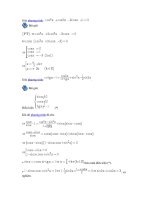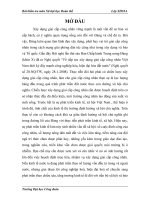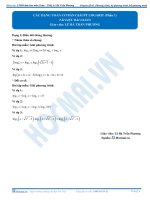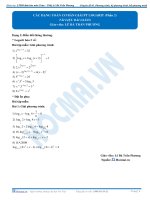sociology research design final assignment
Bạn đang xem bản rút gọn của tài liệu. Xem và tải ngay bản đầy đủ của tài liệu tại đây (196.73 KB, 32 trang )
FOREIGN TRADE UNIVERSITY
**************
GROUP 3
Tống Thị Len - Đồng Minh Huyền - Ngô Thanh Loan – Nguyễn Lan Hương –
Bùi Hạnh Nguyên - Ngô Sơn Tùng
RESEARCH DESIGN
Topic : Emotional Child Abuse
Hà Nội, Ngày 27 tháng 9 năm 2017
TABLE OF CONTENTS
I.
II.
III.
IV.
V.
VI.
VII.
VIII.
Introduction
Literature review
Main concepts and variables
Research questions and hypotheses
Methodology
Information
Conclusion
Reference
3
4
16
17
19
28
30
31
I. INTRODUCTION
Child abuse is undeniably a global issue according to UNISCO. However, in
Vietnam, it is not until recently that the story of child abuse attracted the
Vietnamese society’s attention. Media. has reported that a countable number of
children are being violated in terms of physical and sexual issues without our
awareness. But it has failed to mention the most often type of abuse that many
children are suffering day by day: emotional abuse.
There are not many researches and results, especially about children
emotional abuse. The victims are usually afraid to voice their stories. Recently,
with the spread of information, community is becoming more and more interested
in this subject.
Why the topic is important? Children need both physical and emotional
protection from families and society to develop healthily. While parents are
focusing on keeping their child away of potential physical danger, they may
underestimate the impact of child emotional abuse. Even verbal abuse is emotional
abuse, meaning that everything other people say can be considered as abusing
action to the child. A child who usually suffers from emotional abuse can be
associated with both adverse health and mental health outcomes and those negative
effects last a lifetime. We need a careful research on finding the root, prevention
and intervention to reduce risk factors and promote protective factors to ensure the
well-being of children.
Each of us used to be a child. We might experience ourselves or witness
other child being emotionally and psychologically maltreated. However, at that
time, we didn’t even acknowledge that we were being maltreated and need to be
protected. It is necessary to raise awareness of families and communities in how to
teach children protect themselves.
This research ‘s mission is to find out the real figures of emotional child
abuse as well as how it varies in terms of time, genders and ages, thus build the
basic knowledge for people about an important type of abuse that is happening
daily in our life.
II.LITERATURE REVIEW
There are many researches which have been done on child abuse in general, yet
very few mention emotional abuse.
1
Huong Thanh Nguyen, corresponding authors Michael P Dunne and Anh Vu
Le, "Multiple Types of Child Maltreatment and Adolescent Mental Health in
Viet Nam." PubMed Central (PMC), Bull World Health Organ. 2010 Jan;
88(1):
22–30,
www.ncbi.nlm.nih.gov/pmc/articles/PMC2802435/.
2 Sept. 2009,
The research "Multiple Types of Child Maltreatment and Adolescent Mental Health
in Viet Nam" was conducted with a view of describing the prevalence of child
maltreatment among a large sample of Vietnamese adolescents; examining the
possible cumulative effects of child abuse on depression, anxiety and self-esteem;
analyzing the relative contributions of individual, family background and social
factors and of child maltreatment to the variation seen in the prevalence of mental
health disorders in adolescence; and comparing results in Viet Nam to recent
findings in developed countries. Researchers had carried out a cross-sectional
survey of 2591 students (aged 12–18 years; 52.1% female) from randomly-selected
classes in eight secondary schools in urban (Hanoi) and rural (Hai Duong) areas of
northern Viet Nam (response rate, 94.7%) in 2006 and finally came to the findings:
Females reported more neglect and emotional abuse, whereas males reported more
physical abuse, but no statistically significant difference was found between
genders in the prevalence of sexual abuse. The most important result is linear
functional associations between Maltreatment and depression, anxiety and low
self-esteem were observed. The authors stated that the combined influence of
adverse individual and family background factors and of child maltreatment upon
mental health in adolescents in Viet Nam is consistent with research in non-Asian
countries.
Overall, this research helps us to see the facts of child maltreatment in our country
and confirms its significant effects on adolescent mental health. This study is
among the first to examine the links between child maltreatment and mental health
of young people in Viet Nam. The experiences ranged from unpleasant, common
acts of conflict such as being yelled at or spanked, to being insulted, threatened,
neglected physically or emotionally, and to the relatively less common experiences
of sexual abuse. Among these types of child abuse, emotional abuse is the one
which is strongly associated with later health impacts. However, this study still
leaves an issue for more discussion: In Asian communities like Viet Nam where
child abuse is often construed as severe physical violence only, there has been
relatively little research into emotional maltreatment, “harsh parenting” which
includes high demands and strict controls on behavior is still very common in
society, it is much more important to emphasize the equally pernicious effects of
emotional maltreatment to children.
2
Nhu K. Tran, Sheila R. Van Berkel, Marinus H. van IJzendoorn, and
Lenneke R.A. Alink, "The Association between Child Maltreatment and
Emotional,
Cognitive,
and
Physical
Health
Functioning
in
Vietnam." PubMed Central (PMC), BMC Public Health, 19 Apr. 2017,
www.ncbi.nlm.nih.gov/pmc/articles/PMC5395851/.
This research has just been conducted recently aiming to investigate associations
between different types of child maltreatment and child emotional, cognitive, and
physical health functioning as well as moderation effects of gender and ethnicity.
Through the cross-sectional study conducted with 1851 randomly selected students
aged 12–17 years in four provinces of Northern Vietnam, namely Hanoi, Nam
Dinh, Ha Tinh, and Tuyen Quang, the result of the study once again gives a strong
confirmation to the previous findings that “Even in a culture in which harsh
discipline is normative, child maltreatment was related to negative aspects of child
wellbeing including emotional, cognitive, and physical health functioning:
emotional malfunctioning, poorer perceived physical health and poorer working
memory performance.” Besides, no significant moderation effects by gender and
ethnicity were found.
However, the most noticeable finding of the study is emotional abuse was related
to better academic performance, which might be an indication of “tiger parenting”
practice in Vietnam, implying academic performance stimulation at the expense of
emotional security. In fact, researchers indicate that the prevalence of child
maltreatment in Vietnam was found to be high, emotional abuse was most
prevalent at 31.8%, followed by neglect (25.0%), physical abuse (19.1%),
witnessing parental conflicts (15.3%). As we know, Vietnam is a middle-income
country with a culture highly influenced by Confucianism. In Vietnam, the saying
“Spare the rod, spoil the child” describes the spirit of parenting practices. Physical
and emotional punishment are considered necessary to raise well-behaved children
in Vietnam as well as many other countries in Asia. “Tiger parenting” has rarely
been studied with Vietnamese parents but a qualitative study with a few
Vietnamese-Australian mothers did find that Vietnamese parents had an
authoritarian parenting style and expected high education achievements of their
children.Because there are no studies on “tiger parenting” conducted in Vietnam
and this study did not measure parenting style, the association between emotional
abuse and better academic performance on the one hand and worse emotional
functioning on the other hand might be an indication of “tiger parenting” practice.
This association to answer the question” whether harsh parenting which causes
emotional abuse in Vietnam is right or wrong” is still in controversy and needs to
be further investigated in future research.
3
UNICEF - UNICEF East Asia and Pacific Regional Office (EAPRO). "Child
Maltreatment: Prevalence, Incidence and Consequences in the East Asia and
Pacific Region: A Systematic Review of Research." Home | UNICEF,
United Nations Children’s Fund, Measuring and Monitoring Child
Protection Systems: Proposed Core Indicators for the East Asia and Pacific
Region, Strengthening Child Protection Series No. 1., UNICEF EAPRO,
Bangkok, 2012., 2012, www.unicef.org/eapro/Child_Maltreatment.pdf.
"Child Maltreatment: Prevalence, Incidence and Consequences in the East Asia and
Pacific Region” was published by UNICEF – a famous international organization
for children’ rights protection. This study has systematically reviewed all the
published and unpublished researches that have been conducted on the prevalence
and incidence of child maltreatment in the East Asia and Pacific region. This
review seeks to detail researches undertaken in the last 10 years on both the
magnitude (prevalence and incidence) of child maltreatment and also on the
outcomes for children and adults who have experienced abuse and exploitation in
their childhood. This study utilized a systematic review methodology to examine
364 peer-reviewed and grey literature research studies over 32 countries including
Vietnam on the prevalence and incidence of child physical abuse, sexual abuse,
emotional abuse, neglect, exploitation, witnessing family violence and peer-to-peer
violence as well as the consequences of child maltreatment across five categories
including: 1) education and employment, 2) mental health, 3) physical health, 4)
aggression, violence and criminality and 5) other consequences. Several key
findings both in terms of gaps in research and on maltreatment emerged from this
review: The first gap is that to date, the research on the consequences of child
maltreatment has focused primarily only on mental health. Too little research has
been done linking child maltreatment to physical health outcomes such as
HIV/AIDS, sleeping disorders and self-rated quality of health or measures of
overall health and well-being. The second gap is that despite the growth in studies
overall, there is a lack of high quality qualitative and mixed method studies from
the region. Very few qualitative studies received high quality ratings in this review
primarily due to the lack of detailed information on data sampling techniques and
data analysis. All the qualitative studies rated strongly in their importance to the
field and the recommendations and conclusions drawn. This study suggested that
the evidence base and contextual information provided by qualitative studies in the
region could be strengthened by a continued focus on the study design and
documenting and writing up quality qualitative research.
As this Systematic Review of Research covers all kinds of child abuse but we
focus on the findings on emotional and verbal abuse. The research has come to the
result that: Emotional abuse involves “acts must be reasonably within the control
of the parent or person in a relationship of responsibility, trust or power including
restriction of movement, patterns of belittling, denigrating, threatening, scaring,
discriminating, ridiculing or other non-physical forms of hostile or rejecting
treatment.” A series of studies in the Pacific Islands looked at inappropriate name
calling by an adult in the household within the previous month. Incidence among
16–17 year olds surveyed using the Child Household Questionnaire ranged from
17% in Kiribati to 38% in Vanuatu. This included general swearing at the child,
making fun of their appearance and calling the child ‘lazy’ or ‘stupid’ (UNICEF,
2008; UNICEF, 2009). The studies also examined the prevalence of children being
made to feel unwanted by adults in the household, with incidence ranging from 7%
in Kiribati to 24% in the Solomon Islands (UNICEF, 2008; UNICEF, 2009). In a
study of 3,017 secondary school students (1,331 males and 1,670 females) on
parental psychological control over their children, the authors found psychological
control impairs development and is negatively related to the mental health of the
child. The same study (different publication) found that parental expectation and
discipline were positively related to psychological control. In a qualitative study
exploring the concept of verbal abuse in the Philippines, Figer (2008) stated that
during the interviews, the children candidly shared experiences that had caused
them grief and pain. She says, “It was disquieting to note that in their short lives
they have already gone through disturbing experiences. Their sad experiences
primarily revolved around the context of their family.”
The concept of verbal abuse was seen as an ordinary event in the household. The
children said their parents used denigrating and insulting words against them and
humiliated them in public. This concept is still in controversial and lack of care
from society for the reason of traditional parenting but it actually causes hurt to
child mental health.
4. Dat T. Nguyen, et al., “Depression, Anxiety, and Suicidal Ideation among
Vietnamese Secondary School Students and Proposed Solutions: A Crosssectional Study, BioMed Central Ltd., BMC Public Health, 17 Dec. 2013,
/>
This study aims to determine the prevalence of anxiety, depression, and suicidal
thought to identify related risk factors, and to explore students’ own proposals for
improving their mental health. A cross-sectional study was conducted among 1161
secondary students in Can Tho City, Vietnam during 3 months from September to
December in 2011. The results of the study revealed that suicide had been seriously
considered by 26.3% of the students, while 12.9% had made a suicide plan and
3.8% had attempted suicide.
The author also points out the major risk factors related to anxiety and depression
were physical and emotional abuse by the family, and high educational stress.
When being asked for a proposal, 80% of students suggested that the academic
workload should be reduced and that confidential counselors should be appointed
at schools. Besides, 47.6% respondents wanted the attitudes of their parents and
teachers change to be more supportive rather than punitive . A significant majority
(64%) said that they would share their problems through a website that provided
mental health support for students and 90% agreed that they would really visit such
a site if it existed.
The results of this study revealed one potentially important difference between the
prevalence of mental health problems among Vietnamese students in Can Tho City
(South of Vietnam) and in Da Nang and Khanh Hoa provinces (Central Vietnam).
In this study, female students had a significantly higher risk of anxiety and
depression while the study of Da Nang and Khanh Hoa provinces, undertaken in
2006, found that gender was not significantly associated with overall rates of
anxiety and depression among Vietnamese youth. However, it is important to note
that the previous study only evaluated gender difference in relation to adolescents’
total Strengths & Difficulties Questionnaire (SDQ) scores. The present study
showed a trend consistent with prevalence estimates of mental health problems
among adolescents in Vietnam and in Western countries.
Generally, this study gives us a deep view into the strong connection between
physical and emotional abuse and mental problems in the Vietnamese secondary
students. They are suffering such a heavy burden of academic workload and
parents’ punitive attitude towards their grades and behaviors that the rate of mental
health problems has a tendency to increase. The high expectation from parents also
put more stress on children’s shoulders and the scolding from parents and teachers
whenever children get bad marks became the main factor contributing to children
anxiety and depression. The most feasible strategy in reducing mental health
problems and promoting mental health among secondary school students in
Vietnam today would be the development of a website to provide psychoeducational interventions designed to meet the needs of Vietnamese youth. This
study also opens a new topic of whether or not parents should use abusive methods
of discipline to teach children.
5. Dang Hoang Minh, Hoang Cam Tu, “Mental Health of Secondary
Students in Hanoi and the Need for School Counseling”, Ha Noi Mental
Hospital, 8th Nov. 2016
/>The survey was conducted on 1727 secondary students aging from 12 to 15 in the
center districts Hanoi and the suburban area Thuong Tin. The result shows that
25% students used to have mental health problems, among which 50% shows
symptoms of disorder such as anxiety/depression, somatic complaints, agressive
behaviors and delinquent behaviors. There are many factors may affect the
students’ mental health including family environment, physical trauma,
psychological trauma but stress life events was the most frequent.
The authors used Youth Self – Report (YSR) for children and Teacher’s Report
Form (TRF) for teachers to identify the students who have mental health problems
and set up interventional trial at school, counseling for these students 2 times a
week in a period of 2 months. After 2 months, students and teachers do the YSR
and TRF again. The result is that 30,76% students who have emotional and
behavioral health problems are no longer in the disease.
The survey also comes to a conclusion on the related factors to children mental
health problems which are family environment, incomplete family structure (single
mother or single father, parents’ divorce,…), conflicts between family members,
domestic violence, lack of parental caring, sympathy, affection, or physical health
problems.
In addition to that, the survey strikes an urgent need to school mental health
counsel. Not only the parents but also the school has to be fully prepared and
intensively trained to understand the children’s mentality, identify the problems,
intervene and help them in time. Both the sides should try their best to raise the
awareness of the importance of children mental health, take part in the
psychological education program and provide mental help for children.
III. MAIN CONCEPTS AND VARIABLES:
1. Concepts:
- Child abuse: Child abuse is the physical, sexual, or emotional
mistreatment or neglect of a child or children.
There are four major
categories of child abuse: neglect, physical abuse, psychological/emotional
abuse, and sexual abuse.
- Psychological/emotional abuse: Emotional abuse can include humiliating
the victim privately or publicly, controlling what the victim can and cannot
do, withholding information from the victim, deliberately doing something
to make the victim feel diminished or embarrassed, isolating the victim from
friends and family, implicitly blackmailing the victim by harming others
when the victim expresses independence or happiness, or denying the victim
access to money or other basic resources and necessities. Degradation in any
form can be considered psychological abuse. It could include name-calling,
ridicule, degradation, destruction of personal belongings, torture or killing of
a pet, excessive criticism, inappropriate or excessive demands, withholding
communication, and routine labeling or humiliation..
- Verbal abuse is a form of emotionally abusive behavior involving the use
of language. Verbal abuse can also be referred to as the act of threatening.
Through threatening, a person can blatantly say they will harm you in any
way and will also be considered as abuse.
2. Variables:
-
Independent variables: age, gender, generation
-
Dependent variable: the impact of emotional abuse on victims.
IV. RESEARCH QUESTIONS AND HYPOTHESES
When considering the first part: literature review, we can see that there are still
many controversial points in our topic. With our limited resources of time and
humanity, we try to discover just some questions which we think are the most
necessary. At the same time, we also provide possible hypotheses for later testing
in the research.
1.
Does the seriousness of “emotional child abuse” change from one
generation to another?
On the process of finding the answer for this problem, we want to mention
the previous generations. Whether they suffer from this type of abuse or not,
and if they do, is it different from our modern adolescents nowadays in terms
of causes, forms and extent?
So the hypothesis maybe: “With the widespread of information and
technology, the situation of children now experiencing mental abuse is
more clear and worrisome than the old generations”
2.
In what period of a child’s life does “emotional maltreatment” occur
most seriously?
The extent of abusing differs among different ages. For example, in the early
stage of life, children are less likely to suffer from emotional abuse than
since they start their education.
A possible hypothesis is that:
“Children at the age of 13-18 might be likely to suffer from the most
severe emotional abuse, including verbal abuse as they are compared
with others in terms of many affairs: school performance, competitions,
appearance while experiencing significant changes in mental status.”
[Because of the special feature of the ages (when children experience
significant changes in characters and mentality), the consequences are
incalculable.]
3.
Do its consequences differ between genders? If they do, why?
The conflict between genders exists in almost any fields of our society. It is
important to think about the differences in the performance of emotional
abuse between 2 genders so as to find the right way to deal with the
problem.
There are various ways in which girls and boys may react to abusement.
Our Hypothesis might be:“Because Girls are thought to be more sensitive
to injures than boys, the formers tend to exaggerate it and react
pessimisticly while the laters are often calmer in responding to any
problems, thus, there might be differences in terms of genders when we
look at the consequences of mental abuse”
V.
METHODOLOGY
1 Data collection: Survey
a
Sample and population
As undergraduates in university, we do not have the ability to
conduct large - scale surveys involving millions of people. Our
sample is not too large but enough to represent the situation of the
society to some extent. The sample is 300 students from different
schools in Hanoi (Tran Phu, Chu Van An high schools and
Amsterdam, Doan Thi Diem secondary schools)) with ages ranging
from 11 to 18, in addition to 100 adults living in Hanoi. The
sample includes:
- 50% female and 50% male
- 25 % adults, 35 % secondary school students and 40 % high
b
school students.
Questionnaire
We have understood various advantages of using questionnaire as
the method of collecting data for our research. The following
survey has been scrupulously designed so as to obtain accurate
information. And this questionnaire will be conducted both online
and in paper to optimize the efficiency. We will send these papers
to the schools mentioned above.
Child abuse has been given hands of attention from the society,
however, it is still a sensitive one. So, to secure respondents’
privacy and assure the accuracy of information, we will not ask our
sample’s name and address.
This is our questionnaire:
Survey: Child Abuse
Hello, we come fromK55- advanced undergraduate program
in Economics, Foreign Trade University.
The questionnaire is confidential and any answer you give on
this paper will not be leaked out. If you do not want to answer any
question, you can skip them. But we would be grateful if you
spend a little time to complete all of the questions. Please answer
as what you feel and think in an honest way.
Tick at the option that is true to your thinking,.
1
Are you Male or Female?
Male
Female
2
Age Group
10-13
13-18
Over 18
3
Abuse does NOT just mean domestic and physical
violence.
True
False
4
Child abuse is defined as:
Physical - hitting, harming children etc
Emotional - verbal abuse, threats, unaffectionate
Neglection of childs needs, food, hygeine, etc
All of the above
5
Why do you think only a number of cases of child
abuse have been publicised in the media?
There are so many cases only high profile cases are
publicised
Its a serious issue and people would rather be kept in
the dark about it
There are other issues more important than child abuse
other
6
If you were worried about a child or knew they
were abused would you report it?
Tell a neighbour, relative or friend about their
suspicions first rather than social services or the
police
Yes
No
7
Do you think people who know children are being
abused that do not report it should also be blamed?
Yes
No
Itis none of their business
They might as well be the abusers
While you were growing up, during your first 18 years of life:
8
a)
Did a parent or other adult in the household
often swear at you, insult you, put you down or
humiliate you? Or act in a way that made you
b)
c)
d)
afraid that you might be physically hurt?
Yes
No
If yes, in what stage of your life did it happen
most seriously?
6-10
10-13
13-18
All the time
Another time :____________
What was your reaction at that time?
Feeling sad, discouraged, disappoited about myself,
sometimes crying.
Think about it and try to find causes then solutions
Simply neglect it
To what extent do you think being emotionally
abused has influenced you?
Strong
Weak
Normal
Other:________________
9
Did you often feel that no one in your family loved
you or thought you were important or special? Or
your family didn't look out for each other, feel close
to each other or support each other?
Yes
No
10
Pertaining to the pervious question, do you feel
that you have fallen under the category of "abuse?"
( Remember, abuse is NOT just domestic or physical
)
11
Yes, I have fallen subject to abuse
No, I have not fallen subject to abuse
Do you think that you have emotionally abused
anyone at least once?
Yes
No
c
Depth Interview
We see that parents do not have much free time. So rather than
providing them with papers of questionnaires, we will conduct
interviews with them. This will also obtain their accurate reactions,
respondence and ways of thinking.
Data were collected by means of semi-structured interviews
with student and parent participants. Except for the parents all
participants were interviewed on multiple occasions. Interviews
with participants were conducted by the researcher in settings that
provided visual and auditory privacy. They were conducted oneon-one. At the start of interviews the researcher spent time on
introductions and informally chatting to establish rapport and to
put participants at ease. Participants were reminded of the purpose
of the study and that details of interviews would be kept
confidential.
This is the form of the depth interview
- Why has an adverse problem like Child Abuse existed for such
-
a long time? Who and what should be blame for?
What is the Impact of Child Abuse and Neglect?
What do you think about “spare the rod and spoil the child”?
How do you feel when you are compared to your friends – “con
-
nha nguoi ta”?
Have you ever made comparison between your child to others?
-
Why?
Are victims of child abuse more likely to engage in criminality
-
later in life?
What do you think you will do if you are/ witness a case of
-
child abuse?
Do you know any people/ organisation to report about the case
-
of child abuse?
Do you think girls and boys suffer the abuse in different forms?
List some examples.
2
Data analysis
Interview data were partially transcribed and typed into Microsoft Word
files. Because of the number of interviews carried out, the decision was
taken to only partially transcribe interviews to make the task more
manageable within the study's time constraints.
Through data collection, we can conclude that qualitative analysis of data
is the interpretation of interviews and observation.
In our research, to have an in-depth outlook and understanding about the
concern, we have carried out a number of interviews and participant
observations which is out of our capacity. However, it is not an easy task
because every reaction or response from our participant belongs to visual
terms. It is beyond our ability to know whether these reactions are honest or
find out the root of the response. The information collected is based on the
opinion of each person, which is shaped by their presumptions, family or
their values, etc. So the data maybe biased.
We have resorted descriptive statics as the quantitive analysis of data.
Variation ratio has been used in addition. Another method is summary
data presented in the form of figure, so that they can illustarte the problem in
the clearest and most understandable way. Just count up the number of “yes”
and “no” answers and chart them into percentages. However, there is one
thing that needs to be put in to careful consideration: the artificialty. Because
their answer comes from the willingness, so maybe in some cases, the
answer is not accurate.









